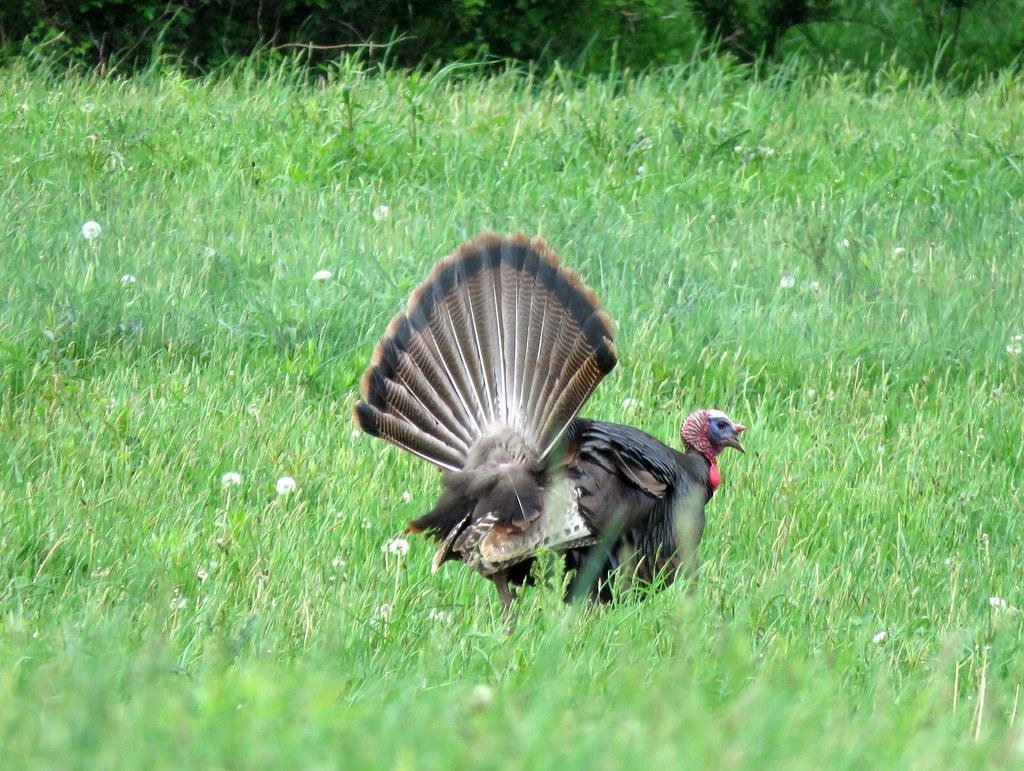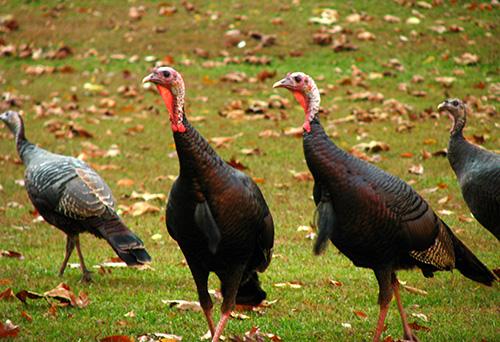
Male wild turkey displaying fanned feathers, Garrett County, 2015. Photo by Josh Emm, Maryland Biodiversity Project
Perhaps spotlighting the Eastern wild turkey is a bit on the nose for a fall newsletter, but it is important to recognize that the species performs a year-round role in the woodlands of Maryland and the mid-Atlantic, beyond the obvious connections to Thanksgiving Day meals.
The Eastern wild turkey is certainly part of North American history. It provided nutrition for the original inhabitants for centuries before the arrival of Europeans. While turkeys were not specifically mentioned as part of the famous 1621 Pilgrims’ feast, it is possible that they were. Additionally, although the story that Benjamin Franklin advocated for the turkey to be the national symbol of the fledgling United States is a myth, he definitely felt it was a noble bird.
Eastern Wild Turkey Basics

Small flock of turkeys. Photo by Kerry Wixted, Maryland DNR
Appearance: Iridescent or black plumage. Males have bare neck and head. Neck is bluish-grey; head color varies red, blue, or white, depending on season. Red lobe of skin (“wattle”) that hangs from neck or chin. Short, rounded wings with black and white bars. Long legs with spurs on back of each that grows throughout lifetime. Females duller in color; grey heads; no spurs on legs.
Size: Males up to 3 feet tall, 4 feet long, 25 lbs. Females roughly half the size.
Lifespan: In the wild, less than 2 years; some have been known to live up to 13 years. |
Unlike many other birds, the turkey requires different habitats during its lifespan. It requires both wooded areas for roosting and for food for the adults of the flock, as well as more open areas, such as fields or edge habitats, for nesting and food sources for the young (called poults). Consequently, many conservation groups advocate for a mix of habitats for individuals or land managers wishing to create suitable turkey habitat. However, the species is highly adaptable, and some flocks have colonized suburban lawns and backyard woods for their own, leading some to experience the birds for the first time beyond a grocery store freezer in November.
Because the turkey does not migrate, they may be found across Maryland year round. As summer yields to fall, the birds may gather into large flocks of up to 100 individuals to find suitable habitat for the winter. With the coming of spring, the large flocks will fragment into groups of 10 to 30. Breeding season begins in March and lasts until May. Males perform elaborate courtship rituals, gobbling, dragging their wing tips on the ground, and displaying their fan-shaped tail feathers as they strut around the females and to assert their dominance over other males. The female lays her eggs in a nest that is generally nothing more elaborate than a depression in the ground. However, the surrounding area is usually densely vegetated to hide the female and the eggs from predators. The clutch is usually 9-12 eggs, laid one at a time and one per day. The eggs are incubated for approximately a month and will all hatch at once.
Soon the poults will leave the nest with the female for open areas, which provide the insects that form their diet for the first few weeks of their life. Over half of the poults fail to reach maturity, falling victim to predators or to cold, wet weather before they are able to fly into trees for escape and for roosting. As they mature, their diet expands to include acorns, nuts, leaves, seeds, and fruit. They scratch the ground with their feet to uncover their food, and typically forage for two to three hours after dawn and before dusk.
When confronted by predators or when surprised by humans, individuals and flocks generally run away, but the turkey can fly, and with great speed - up to 50 miles an hour for short distances. They have excellent eyesight and hearing, which are up to five times greater than humans.
Adult turkeys can fall victim to bobcats, raccoons, eagles and owls. Other birds, mammals, and snakes often consume turkey eggs. But humans are by far the birds’ largest predators. A combination of habitat loss through land clearing and hunting resulted in turkeys disappearing from all of Maryland, except for some scattered populations in western counties.
A reintroduction program by the Department of Natural Resources and partner organizations began in 1979 and restored the species to Maryland. These efforts, along with habitat management efforts by interested property owners, have resulted in a healthy turkey population across the state. Consequently, the state DNR has established hunting seasons in both spring and fall to help manage the species.
 English
English العربية
العربية Български
Български 简体中文
简体中文 繁體中文
繁體中文 Hrvatski
Hrvatski Čeština
Čeština Dansk
Dansk Nederlands
Nederlands Suomi
Suomi Français
Français Deutsch
Deutsch Ελληνικά
Ελληνικά हिन्दी
हिन्दी Italiano
Italiano 日本語
日本語 한국어
한국어 Norsk bokmål
Norsk bokmål Polski
Polski Português
Português Română
Română Русский
Русский Español
Español Svenska
Svenska Català
Català Filipino
Filipino עִבְרִית
עִבְרִית Bahasa Indonesia
Bahasa Indonesia Latviešu valoda
Latviešu valoda Lietuvių kalba
Lietuvių kalba Српски језик
Српски језик Slovenčina
Slovenčina Slovenščina
Slovenščina Українська
Українська Tiếng Việt
Tiếng Việt Shqip
Shqip Eesti
Eesti Galego
Galego Magyar
Magyar Maltese
Maltese ไทย
ไทย Türkçe
Türkçe فارسی
فارسی Afrikaans
Afrikaans Bahasa Melayu
Bahasa Melayu Kiswahili
Kiswahili Gaeilge
Gaeilge Cymraeg
Cymraeg Беларуская мова
Беларуская мова Íslenska
Íslenska Македонски јазик
Македонски јазик יידיש
יידיש Հայերեն
Հայերեն Azərbaycan dili
Azərbaycan dili Euskara
Euskara ქართული
ქართული Kreyol ayisyen
Kreyol ayisyen اردو
اردو বাংলা
বাংলা Bosanski
Bosanski Cebuano
Cebuano Esperanto
Esperanto ગુજરાતી
ગુજરાતી Harshen Hausa
Harshen Hausa Hmong
Hmong Igbo
Igbo Basa Jawa
Basa Jawa ಕನ್ನಡ
ಕನ್ನಡ ភាសាខ្មែរ
ភាសាខ្មែរ ພາສາລາວ
ພາສາລາວ Latin
Latin Te Reo Māori
Te Reo Māori मराठी
मराठी Монгол
Монгол नेपाली
नेपाली ਪੰਜਾਬੀ
ਪੰਜਾਬੀ Afsoomaali
Afsoomaali தமிழ்
தமிழ் తెలుగు
తెలుగు Yorùbá
Yorùbá Zulu
Zulu ဗမာစာ
ဗမာစာ Chichewa
Chichewa Қазақ тілі
Қазақ тілі Malagasy
Malagasy മലയാളം
മലയാളം සිංහල
සිංහල Sesotho
Sesotho Basa Sunda
Basa Sunda Тоҷикӣ
Тоҷикӣ O‘zbekcha
O‘zbekcha አማርኛ
አማርኛ Corsu
Corsu Ōlelo Hawaiʻi
Ōlelo Hawaiʻi كوردی
كوردی Кыргызча
Кыргызча Lëtzebuergesch
Lëtzebuergesch پښتو
پښتو Samoan
Samoan Gàidhlig
Gàidhlig Shona
Shona سنڌي
سنڌي Frysk
Frysk isiXhosa
isiXhosa